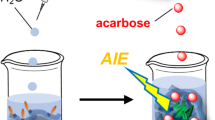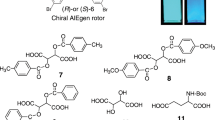Abstract
MEANS of distinguishing between enantiomers of a chiral molecule are of critical importance in many areas of analytical chemistry and biotechnology, particularly in drug design and synthesis. In particular, solution-based sensor systems capable of chiral recognition would be of tremendous pharmaceutical value. Here we report the chiral discrimination of D- and L -monosaccharides using a designed receptor molecule that acts as a sensor by virtue of its fluorescent response to binding of the guest species. Our receptor contains boronic acid groups that bind saccharides by covalent interactions; such receptor systems have been much studied previously1–6 for complexation of saccharides, and have an advantage over others based on hydrogen-bonding interactions7–11, for which polar protic solvents such as water can compete with guest binding. Our molecular sensor also incorporates a fluorescent naphthyl moiety; binding of each enantiomer of the monosaccharides alters the fluorescence intensity to differing degrees, enabling them to be distinguished. These water-soluble molecular sensors might form the basis of a quantitative and selective analytical method for saccharides.
This is a preview of subscription content, access via your institution
Access options
Subscribe to this journal
Receive 51 print issues and online access
$199.00 per year
only $3.90 per issue
Buy this article
- Purchase on Springer Link
- Instant access to full article PDF
Prices may be subject to local taxes which are calculated during checkout
Similar content being viewed by others
References
Deng, G., James, T. D. & Shinkai, S. J. Am. chem. Soc. 116, 4567–4572 (1994).
James, T. D., Sandanayake, K. R. A. S. & Shinkai, S. J. chem. Soc., chem. Commun. 477–478 (1994).
James, T. D., Sandanayake, K. R. A. S. & Shinkai, S. Angew. Chem. 33, 2207–2209 (1994).
Yoon, J. & Czarnik, A. W. J. Am. chem. Soc. 114, 5874–5875 (1992).
Morin, G. T., Hughes, M. P., Paugam, M.-F. & Smith, B. D. J. Am. chem. Soc. 116, 8895–8901 (1994).
Wulff, G. Pure appl. Chem. 54, 2093–2102 (1982).
Rebek, J. Jr Angew. Chem. 29, 245–255 (1990).
Goswami, S. & Hamilton, A. D. J. Am. chem. Soc. 111, 3425–3426 (1989).
Kelly, T. R., Zhao, C. & Bridger, G. J. J. Am. chem. Soc. 111, 3744–3745 (1989).
Etter, M. C. & Adsmond, D. A. J. chem. Soc., chem. Commun. 589–591 (1990).
Aoyama, Y., Tanaka, Y., Toi, H. & Ogoshi, H. J. Am. chem. Soc. 110, 634–635 (1988).
Bissel, R. A. et al. Top. Curr. Chem. 168, 223–264 (1993).
Czarnik, A. W. Fluorescent Chemosensors for Ion and Molecular Recognition (ACS Books, Washington DC, 1993).
Lorand, J. P. & Edwards, J. D. J. org. Chem. 24, 769–774 (1959).
Irie, M., Yorozu, T. & Hayashi, K. J. Am. chem. Soc. 100, 2236–2237 (1978).
Yorozu, T., Hayashi, K. & Irie, M. J. Am. chem. Soc. 103, 5480–5484 (1981).
Brunner, H. & Goldbrunner, J. Chem. Ber. 122, 2005–2009 (1989).
Bruner, H. & Wultz, K. New J. Chem. 16, 57–61 (1992).
Brunner, H. & Schiessling, H. Angew. Chem. 33, 125–126 (1994).
Perrin, D. D. & Dempsey, B. Buffers for pH and Metal Ion Control Ch. 6 (Chapman & Hall, London, 1974).
Fery-forgues, S., LeBris, M.-T., Guette, J.-P. & Valeur, B. J. phys. Chem. 92, 6233–6237 (1988).
Author information
Authors and Affiliations
Rights and permissions
About this article
Cite this article
James, T., Samankumara Sandanayake, K. & Shinkai, S. Chiral discrimination of monosaccharides using a fluorescent molecular sensor. Nature 374, 345–347 (1995). https://doi.org/10.1038/374345a0
Received:
Accepted:
Issue Date:
DOI: https://doi.org/10.1038/374345a0
This article is cited by
-
Predicting the effects of degradation on viscoelastic relaxation time using model transient networks
Polymer Journal (2024)
-
Fluorophore-glucan conjugate for oligosaccharide sensing in aqueous media
Polymer Journal (2024)
-
Models for boronic acid receptors II: a computational structural, bonding, and thermochemical investigation of the RB(OH)2∙H2O∙NH3 and RB(−OCH2CH2O−)∙NH3∙H2O potential energy surfaces (R = H, methyl, phenyl, and ortho-methyl-phenyl)
Structural Chemistry (2023)
-
Smart polymer chemosensors: signal-amplification systems with allosterism
Polymer Journal (2021)
-
Models for boronic acid receptors: a computational structural, bonding, and thermochemical investigation of the HB(OH)2∙H2O∙NH3 and HB(-O-CH2-CH2-O-)∙NH3∙H2O potential energy surfaces
Structural Chemistry (2021)
Comments
By submitting a comment you agree to abide by our Terms and Community Guidelines. If you find something abusive or that does not comply with our terms or guidelines please flag it as inappropriate.



